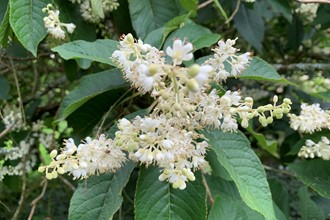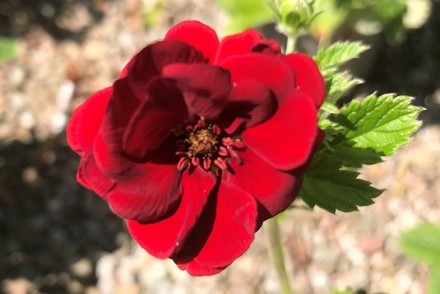Are you ready to start a National Plant Collection?
The missing collections campaign asks people with a passion for plants to start a National Plant Collection of their own, and join Plant Heritage in growing, sharing and saving plants.
Every year we highlight much-loved plant groups that are currently not represented by an accredited National Plant Collection and this year we are focussing on pollinator-friendly plant groups. Thanks to this campaign, in recent years we have seen new collections coming through for Baptisia, Eryngium, Verbena, Alcea, Ginkgo, Thalictrum, Tradescantia and Aeonium.
In addition to this year's choice, there are actually several groups of garden plants grown in the UK that are not showcased in a collection. So, whether you're curious about plants, big or small, we are confident that there will be a plant group to suit your passion.
Missing collections highlighted for 2025 include:
Argyranthemum: Often grown in pots, their large daisy shaped flowers add bursts of colour from late spring to the first frosts. Their long blooming season attracts a range of pollinators too, including honeybees.
Caryopteris: Best in a sunny border or gravel garden with free-draining soil, these fluffy blue-purple flowers are striking in late summer and early autumn, providing late-season nectar for butterflies and bees.
Clethra: Also known as Summersweet, these fragrant flowers and their nectar attract a wide variety of butterflies and songbirds in the summer, and seeds in winter.
Erysimum: ommonly known as wallflowers, are spring to summer-flowering plants that provide vibrant displays of colour. Many varieties are hardy perennials and have attractive evergreen foliage, adding structure and aesthetic value to the garden even after the flowers have faded.

Argyranthemum 'Vancouver'
© Plant Heritage

Caryopteris x clandonensis 'Heavenly Blue'
© Plant Heritage

Clethra barbinervis
© Marwood Hill Gardens

Erysimum 'Butterscotch'
© Plant Heritage
Gaillardia: Known as Blanket Flowers for their masses of richly coloured, daisy-like flowers in vivid shades of red, yellow and orange. Perfect for a wildlife garden, they bloom from late spring to early autumn and appeal to butterflies, bees, beetles and birds for their seeds.
Ligularia: Another daisy-like flower, these imposing herbaceous perennials are ideal in boggy areas and alongside water features, and cater well for butterflies, bees and hoverflies.
Lysimachia: Related to Primula and Lythrum, they thrive in full sun if the soil remains moist. They form upright dense spikes with yellow or white flowers, and their pollen and nectar attracts many species. Some types also produce floral oils which attract loosestrife bees.

Gaillardia pulchella
© Public Domain Image Flickr

Ligularia × Yoshizoeana 'Palmatiloba'
© Plant Heritage

Lysimachia clethroides
© Plant Heritage
Osteospermum: Also known as Cape Daisy or African Daisy, these long-lasting colourful flowers are beautiful from summer to autumn. Another favourite with pollinators.
Potentilla (herbaceous): This huge but recognisable genus flowers from late spring through to autumn. It’s a favourite of many pollinators and is one of the known food sources for the larvae of the rare grizzled skipper butterfly.
Verbascum: With their distinctive, upright spires of flowers, these pretty perennials (or biennials) – which come in white, yellow, orange, blue or purple – are great for bees, hoverflies and moths.

Osteospermum 'Sennen Sunrise'
© Plant Heritage

Potentilla 'Velours Pourpre'
© Plant Heritage

Verbascum 'Clementine'
© Plant Heritage
Collections don't just have to be based around a single genus. Many are put together in recognition of a noted breeder or plantsperson, or around the plants bred at a specific place.
The heritage of these people and plants is important to research and conserve before they are lost to horticulture. There are some suggestions below but this is the tip of the iceberg!
Plants associated with Valerie Finnis
Valerie Finnis had a strong association with Waterperry Horticultural School for Women in Oxfordshire, where she taught for many years, and in later life lived at Boughton House in Northamptonshire.
Plants still available include:
- Artemisia ludoviciana ‘Valerie Finnis’
- Artemisia stelleriana ‘Boughton Silver’
- Clematis 'Bill MacKenzie’ (C. orientalis x C. tangutica)
- Dianthus ‘Fair Folly’ syn. ‘Constance Finnis'
- Helianthemum 'Boughton Double Primrose'
- Helleborus x sternii ‘Boughton Beauty’
- Muscari armeniacum syn neglectum 'Valerie Finnis’
- Veronica albicans (Recurva Group) 'Boughton Silver' (H)
- Veronica cupressoides ‘Boughton Dome’
- Viola ‘Belmont Blue’ syn. ‘Boughton Blue’
Others that may be harder to find include: Achillea ptarmica 'Boughton Beauty', Allium ‘Valerie Finnis’, Berberis ‘Boughton Red’ , Clematis integrifolia ‘Finnis Form’ (I), Dactylorhiza ‘Valerie Finnis’, Dianthus ‘Valerie Finnis’, Erysimum ‘Valerie Finnis’, Glandularia ‘Boughton House’, Helleborus x sternii Boughton Group syn. ‘Boughton Beauty Strain’, Nepeta ‘Valerie Finnis’, Osteospermum ‘Valerie Finnis’, Papaver (Oriental Group) ‘Constance Finnis’, Papaver rhoeas ‘Valerie Finnis’, Thymus ‘Valerie Finnis’
Plants associated with Margery Fish
Margery Fish was a gardener and garden writer who influenced the informal cottage garden style of gardens. The garden she created, at East Lambrook Manor in Somerset is still in existence as an English Heritage grade 1 listed garden. But what about the plants?
Plants still available include:
- Penstemon ‘Margery Fish’
- Astrantia ‘Shaggy’ syn. ‘Margery Fish’
- Bergenia ‘Margery Fish’ syn. ‘Lambrook’
- Pulmonaria ‘Margery Fish’
- Euphorbia characias subsp. wulfenii Margery Fish Group syn. ‘Lambrook Gold’
- Galanthus nivalis ‘Margery Fish’
- Chrysanthemum ‘Margery Fish’
Others that may be harder to find are: Lamium maculatum ‘Margery Fish’, Nerine bowdenii ‘Margery Fish’, Penstemon ‘Sour Grapes’ M. Fish, Stachys byzantina ‘Margery Fish’, Veronica ‘Primley Gem’ syn. Hebe ‘Margery Fish’
Plants bred by Bees' Nursery, Cheshire
Bees' was founded in 1904 as the commercial side of Arthur Bulley's Ness Garden - now Ness Botanic Garden. He hired many of the plant hunters of the day to bring back unusual specimens to sell.
Plants still available include:
- Clematis 'Bees' Jubilee'
- Kniphofia ‘Bees’ Jubilee’
- Kniphofia 'Bees' Lemon'
- Kniphofia 'Bees' Sunset' syn. ‘Shining Sceptre’
- Lobelia cardinalis 'Bees' Flame'
- Primula beesiana
May be harder to find: Armeria Bees' hybrids, Armeria ‘Bees’ Ruby’, Lobelia ‘Bees’ Ridge’, Kniphofia ‘Bees’ Orange’, Kniphofia ‘Bees’ Yellow’, Kniphofia ‘Bees’ Golden Amber’, Kniphofia ‘Bees’ Red Guard’, Kniphofia ‘Bees’ Yellow Monarch’, Kniphofia ‘Bees’ Torch’, Kniphofia ‘Bees’ Flame’, Kniphofia ‘Bees’ Amber’, Kniphofia ‘Bees’ Cherry Red’, Kniphofia ‘Bees’ Sunrise’, Tanacetum coccineum 'Bees' Jubilee', Tanacetum coccineum 'Bees' Pink Delight’
Plants associated with Gertrude Jekyll
Jekyll designed over 400 gardens in the UK and from her garden centre in Munstead Wood, Surrey, bred many plants too.
Plants still available include:
- Aquilegia vulgaris ‘Nivea’ syn. ‘Munstead White’
- Lavandula angustifolia 'Munstead'
- Nigella damascena 'Miss Jekyll' & ‘Miss Jekyll Alba’
- Pulmonaria angustifolia 'Munstead Blue'
- Rosa [Gertrude Jekyll]=('Ausbord')
- Rosa [Munstead Wood]=('Ausbernard')
- Hylotelephium syn. Sedum 'Munstead Red'
- Hylotelephium ‘Munstead Purple’
- Lunaria annua ‘Munstead Purple’
- Vinca minor f. alba 'Gertrude Jekyll'
May be harder to find: Bignonia capreolata ‘Jekyll’, Coleus scutellarioides ‘Gertrude Jekyll’, Helleborus foetidus ‘Miss Jekyll’, Primula Munstead strain, Pulmonaria angustifolia ‘Munstead Variety’, Rhododendron ‘Gertrude Jekyll’, Rhododendron ‘Munstead’
Interested? Take a look at how to start a National Plant Collection,
or find out more about other collections ideas here.
Download the full list of missing collections.

